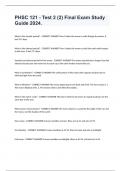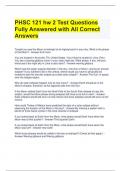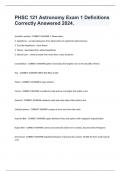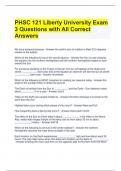Phsc 121 test 2 - Study guides, Class notes & Summaries
Looking for the best study guides, study notes and summaries about Phsc 121 test 2? On this page you'll find 7 study documents about Phsc 121 test 2.
All 7 results
Sort by

-
PHSC 121 Test 2 Questions with All Correct Answers
- Exam (elaborations) • 5 pages • 2024
-
Available in package deal
-
- $12.99
- + learn more
PHSC 121 Test 2 Questions with All Correct Answers What is the Synodic period? - Answer-Time it takes the moon to orbit though its phases. It last 29.5 days. What is the sidereal period? - Answer-Time it takes the moon to orbit the earth with respect to the stars. It last 27.3 days Synodal and sidereal period for the moon - Answer-The moons synodal day is longer than the sidereal day because the moon has to catch up to the earth motion around the sun. What is earthshine? - Answer-Th...

-
PHSC 121 - Test 2 (2) Final Exam Study Guide 2024.
- Exam (elaborations) • 6 pages • 2024
-
Available in package deal
-
- $11.49
- + learn more
PHSC 121 - Test 2 (2) Final Exam Study Guide 2024. What is the Synodic period? - CORRECT ANSWER Time it takes the moon to orbit though its phases. It last 29.5 days. What is the sidereal period? - CORRECT ANSWER Time it takes the moon to orbit the earth with respect to the stars. It last 27.3 days Synodal and sidereal period for the moon - CORRECT ANSWER The moons synodal day is longer than the sidereal day because the moon has to catch up to the earth motion around the sun. What i...

-
PHSC 121 hw 2 Test Questions Fully Answered with All Correct Answers
- Exam (elaborations) • 3 pages • 2024
-
Available in package deal
-
- $12.99
- + learn more
PHSC 121 hw 2 Test Questions Fully Answered with All Correct Answers Tonight you see the Moon at midnight at its highest point in your sky. What is the phase of the Moon? - Answer-Full moon You are located in Knoxville, TN, United States. Your friend is located in Lima, Peru. You see a waning gibbous moon in your clear night sky. What phase, if any, will your friend see if the night sky in Lima is also clear? - Answer-waning gibbous Which has the larger angular diameter in the sky—the S...

-
PHSC 121 Astronomy Exam 1 Definitions Correctly Answered 2024.
- Exam (elaborations) • 3 pages • 2024
-
Available in package deal
-
- $11.49
- + learn more
PHSC 121 Astronomy Exam 1 Definitions Correctly Answered 2024. Scientific method - CORRECT ANSWER 1. Observation 2. Hypothesis - an educated guess from observation to explain the phenomenon 3. Test the Hypothesis - many times! 4. Theory - developed from tested hypothesis 5. Natural Law - a theory tested over much time, many situations Constellation - CORRECT ANSWER pattern formed by the brighter stars in the sky (88 of them) Star - CORRECT ANSWER GREAT BIG BALL O GAS Planet - C...

-
PHSC 121 Test 3 Exam Questions All Solved
- Exam (elaborations) • 7 pages • 2024
-
Available in package deal
-
- $10.99
- + learn more
PHSC 121 Test 3 Exam Questions All Solved We have seasons because? - Answer -The earth's axis of rotation is tilted 23.5 degrees relative to the ecliptic Which of the following is true of the vernal equinox? - Answer -the Sun is now crossing the equator into the northern hemisphere and the northern hemisphere begins to face toward the Sun. Which of the following is NOT true of the winter solstice? - Answer -the northern hemisphere receives the most direct sunlight of the year For so...

-
Astronomy Chap 5 (Liberty University) (PHSC 121) Review Practice Test 2024.
- Exam (elaborations) • 3 pages • 2024
-
Available in package deal
-
- $10.99
- + learn more
Astronomy Chap 5 (Liberty University) (PHSC 121) Review Practice Test 2024. What is the orbital speed at Earth's surface? Ignore atmospheric friction. (Note: Earth's average radius is , Earth's mass is , 6370 km, Earth's mass is 5.97x 10(24) kg, G= 6.67 x 10(-11) m(3)/ kg x s(2) - CORRECT ANSWER 7900 m/s When you ride a fast elevator upward, you feel slightly heavier as the trip begins and slightly lighter as the trip ends. How is this phenomenon related to the equivalence principle?...

-
Bundle For PHSC 121 Exam Questions with All Correct Answers
- Package deal • 12 items • 2024
-
- $61.59
- + learn more
PHSC 121 Liberty University Exam 3 Questions with All Correct Answers 2 Exam (elaborations) PHSC 121 FINAL EXAM QUESTIONS AND ANSWERS GRADED A+ 3 Exam (elaborations) PHSC 121 Test 2 Questions with All Correct Answers 4 Exam (elaborations) PHSCS 121 Final Exam Questions with Correct Answers 5 Exam (elaborations) PHSC 121 B06 LUO EXAM QUESTIONS W

How much did you already spend on Stuvia? Imagine there are plenty more of you out there paying for study notes, but this time YOU are the seller. Ka-ching! Discover all about earning on Stuvia


